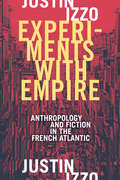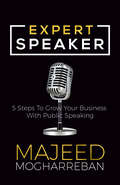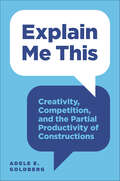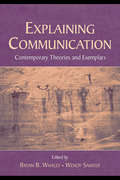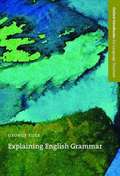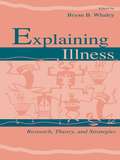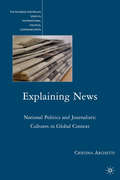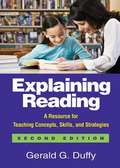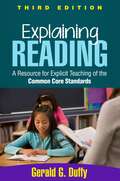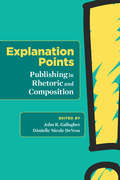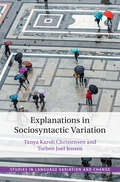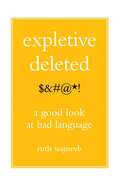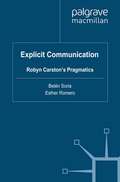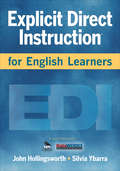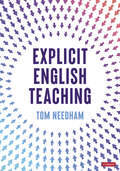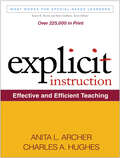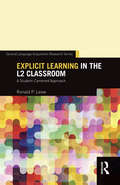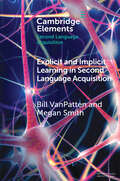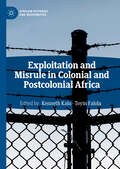- Table View
- List View
Experiments in a Jazz Aesthetic
by Omi Osun Joni L. Jones Lisa L. Moore Sharon BridgforthIn Austin, Texas, in 2002, a group of artists, activists, and academics led by performance studies scholar Omi Osun Joni L. Jones formed the Austin Project (tAP), which meets annually in order to provide a space for women of colour and their allies to build relationships based on trust, creativity, and commitment to social justice by working together to write and perform work in the jazz aesthetic. Inspired by this experience, this book is both an anthology of new writing and a sourcebook for those who would like to use creative writing and performance to energize their artistic, scholarly, and activist practices. Theoretical and historical essays by Omi Osun Joni L. Jones describe and define the African American tradition of art-making known as the jazz aesthetic, and explain how her own work in this tradition inspired her to start tAP. Key artists in the tradition, from Bessie Award-winning choreographer Laurie Carlos and writer/performer Robbie McCauley to playwrights Daniel Alexander Jones and Carl Hancock Rux, worked with the women of tAP as mentors and teachers. This book brings together never-before-published, must-read materials by these nationally known artists and the transformative writing of tAP participants. A handbook for workshop leaders by Lambda Literary Award-winning writer Sharon Bridgforth, tAP's inaugural anchor artist, offers readers the tools for starting similar projects in their own communities. A full-length script of the 2005 tAP performance is an original documentation of the collaborative, breath-based, body work of the jazz aesthetic in theatre, and provides both a script for use by theatre artists and an invaluable documentation of a major transformative movement in contemporary performance.
Experiments with Empire: Anthropology and Fiction in the French Atlantic (Theory in Forms)
by Justin IzzoIn Experiments with Empire Justin Izzo examines how twentieth-century writers, artists, and anthropologists from France, West Africa, and the Caribbean experimented with ethnography and fiction in order to explore new ways of knowing the colonial and postcolonial world. Focusing on novels, films, and ethnographies that combine fictive elements and anthropological methods and modes of thought, Izzo shows how empire gives ethnographic fictions the raw materials for thinking beyond empire's political and epistemological boundaries. In works by French surrealist writer Michel Leiris and filmmaker Jean Rouch, Malian writer Amadou Hampâté Bâ, Martinican author Patrick Chamoiseau, and others, anthropology no longer functions on behalf of imperialism as a way to understand and administer colonized peoples; its relationship with imperialism gives writers and artists the opportunity for textual experimentation and political provocation. It also, Izzo contends, helps readers to better make sense of the complicated legacy of imperialism and to imagine new democratic futures.
Expert Speaker: 5 Steps To Grow Your Business With Public Speaking
by Majeed MogharrebanFor those looking to become a highly-paid speaker who makes a difference, Expert Speaker reveals how to take the stage by being an expert, not the expert. The fastest way to build authority, get one’s name out to the public, and attract premium clients is by public speaking. The truth is, not just any speech will win stages and attract the right clients. In Expert Speaker, ExpertSpeaker.com founder Majeed Mogharreban draws from his ten years of experience as a professional speaker to help readers build their brands, grow their business, and amplify their message in a way that makes a difference. Expert Speaker teaches those who are serious about public speaking what to say to get booked, how to give a speech that builds authority, how to negotiate their speaker fee, and so much more. Majeed walks readers through every aspect of public speaking so they too can amplify their message and take control over the big stage of their career.
Explain Me This: Creativity, Competition, and the Partial Productivity of Constructions
by Adele E. GoldbergWhy our use of language is highly creative yet also constrainedWe use words and phrases creatively to express ourselves in ever-changing contexts, readily extending language constructions in new ways. Yet native speakers also implicitly know when a creative and easily interpretable formulation—such as “Explain me this” or “She considered to go”—doesn’t sound quite right. In this incisive book, Adele Goldberg explores how these creative but constrained language skills emerge from a combination of general cognitive mechanisms and experience. Shedding critical light on an enduring linguistic paradox, Goldberg demonstrates how words and abstract constructions are generalized and constrained in the same ways. When learning language, we record partially abstracted tokens of language within the high-dimensional conceptual space that is used when we speak or listen. Our implicit knowledge of language includes dimensions related to form, function, and social context. At the same time, abstract memory traces of linguistic usage-events cluster together on a subset of dimensions, with overlapping aspects strengthened via repetition. In this way, dynamic categories that correspond to words and abstract constructions emerge from partially overlapping memory traces, and as a result, distinct words and constructions compete with one another each time we select them to express our intended messages.While much of the research on this puzzle has favored semantic or functional explanations over statistical ones, Goldberg’s approach stresses that both the functional and statistical aspects of constructions emerge from the same learning mechanisms.
Explaining Communication: Contemporary Theories and Exemplars (Routledge Communication Series)
by Bryan B. Whaley Wendy SamterOffering a direct sightline into communication theory, Explaining Communication provides in-depth discussions of communication theories by some of the foremost scholars working in communication today. With contributions from the original theorists and scholars known for their work in specific theoretical perspectives, this distinctive text breaks new ground in giving these scholars the opportunity to address students firsthand, speaking directly to the coming generations of communication scholars. Covering a wide range of interpersonal communication theories, the scope of this exceptional volume includes:*the nature of theory and fundamental concepts in interpersonal communication;*theories accounting for individual differences in message production; explanations of human communication from dyadic, relational, and/or cultural levels; and*a history of communication theory. Chapter authors offer their own views of the core ideas and findings of specific theoretical perspectives, discussing the phenomena those perspectives are best positioned to explain, how the theories fit into the field, and where future research efforts are best placed. While by no means comprehensive, Explaining Communication includes those theories that rank among those most often used in today’s work, that have generated a substantial body of knowledge over time, and that have not been articulated in detail in other publications. With detailed explorations and first-hand discussions of major communication theories, this volume is essential for students in communication studies, interpersonal communication, and advanced theory courses, as well as for scholars needing a thorough reference to some of the most salient theories in communication today.
Explaining English Grammar
by George YuleHaving to explain a grammar point can be daunting for teachers. The kinds of explanations that will help language students aren't always the ones you will find in a traditional, 'academic' grammar book or guide. Instead, Explaining English Grammar is a pedagogical guide, designed to help explain the 'whys' as well as the 'hows' of English grammar. The book is organized into ten chapters. Each chapter covers a specific grammar topic.
Explaining Illness: Research, Theory, and Strategies (Routledge Communication Series)
by Bryan B. WhaleyUnderstanding one's health conditions plays a key role in a patient's response to illness, influencing stress levels and the likelihood of following treatment regimens and advice. Thus, the explanation of illness is a critical component of the interactions between health care providers and their patients. Emphasizing these exchanges and their potential for improving health and well being, Bryan B. Whaley has assembled this collection to serve both as a foundation for further research on explaining illness and as a resource for provider-patient interaction. Contributors from the communication and health care disciplines examine the purpose and methods of explaining illness, as well as the role that illness explanations play in framing and reframing meaning and uncertainty regarding one's health welfare. Including theoretical, developmental, and cultural factors, the elegance of this book is the richness in the differences among populations and communication strategies, and the articulation of the intricacies of language, illness, and culture in the explanations. As a resource for scholars and students of communication, medicine, nursing, public health, social work, and related areas, this volume establishes a benchmark from which to examine and evaluate current theory and strategies in explaining illness, and to launch systematic research endeavors. Health practitioners will also find the book invaluable in their exchanges with their patients, as a unique source of information on the factors influencing the explanation of illness.
Explaining News
by Cristina ArchettiThe book develops a new multidisciplinary model to understand elite press news in the twenty-first century.
Explaining One's Self To Others: Reason-giving in A Social Context (Routledge Communication Series)
by Stephen J. Read Margaret L. McLaughlin Michael J. CodyTo date, the study of communicated explanations has been, at best, unsystematic. There has been little recognition that many, if not most, explanations are eventually delivered to a hearer or hearers. These potential audiences constrain the way the explanation is ultimately shaped. Similarly, researchers have devoted themselves to the study of "accounts," for the most part without an accompanying interest in the fundamental processes of event comprehension. This volume is devoted to bridging the gap between these two traditions.
Explaining Reading, Second Edition
by Richard Allington Gerald DuffyThis bestselling teacher resource and widely adopted text demonstrates the 'whats,' 'whys,' and 'how-tos' of explicit reading instruction for struggling K 8 learners. The book describes 23 skills and strategies associated with vocabulary, comprehension, word recognition, and fluency. Ways to explain each skill or strategy are illustrated in real-world examples that teachers can use as starting points for their own lessons. Retaining the straight-talking style that made the prior edition so popular, the second edition has been revised and updated to reflect reader feedback and the latest research. New to This Edition Incorporates important new research on vocabulary and comprehension. Stronger emphasis on embedding instruction in authentic reading experiences. A chapter on teaching "big-picture" ideas about strategy use. Revised teaching examples are even more thorough and teacher friendly
Explaining Reading, Third Edition
by Gerald G. DuffyThis trusted teacher resource and widely adopted text presents effective ways to demystify essential reading skills and strategies for K-8 students who are struggling. It has been fully revised to focus on the Common Core State Standards (CCSS) for English language arts. Following a concise introduction to the CCSS and explicit teaching, 30 engaging examples show how to be explicit when teaching each Literature, Informational Text, and Foundational Skills standard. Grounded in authentic reading tasks that teachers can adapt for their classrooms, the examples guide teachers to differentiate instruction, model and scaffold learning, assess student skills, and align reading instruction with Common Core writing standards. New to This Edition *Significantly revised and restructured with a CCSS focus. *The teaching examples are all new or revised. *Provides practical ways to develop "close reading" of text. *Incorporates recent research on authentic tasks and adaptive teaching.
Explanation Points: Publishing in Rhetoric and Composition
by John R. Gallagher Dànielle Nicole DeVossExplanation Points is a curated collection of disciplinary knowledge and advice for publishing in rhetoric and composition. Covering a variety of topics in an approachable, conversational tone, the book demonstrates how writing faculty from diverse career trajectories and institutions produce, prepare, edit, revise, and publish scholarship. Rhetoric and composition is a uniquely democratic field, made of a group of scholars who, rather than competing with one another, lift each other up and work together to move the field forward. This lively, engaging, story-anchored book offers advice from a range of authors—including emeritus faculty, prolific authors, and early career researchers. Organized by various stages in the writing and publishing process, Explanation Points presents the advice shared between colleagues, passed along from professor to student, or offered online in abbreviated tweets and updates. The best advice book on writing and publishing in the field, Explanation Points is a useful resource for rhetoric and composition scholars including faculty, graduate students, and advanced undergraduate students; writing center administrators, staff, and consultants; graduate pratica and seminars; writing workshop classes; and editors, associate editors, assistant editors, and other academic journal staff. Contributors: Tim Amidon, Chris Anson, Nancy G. Barron, Ellen Barton, Michael Baumann, Steve Bernhardt, Kristine L. Blair, David Blakesley, Lynn Z. Bloom, Marcia Bost, James Brown, Amber Buck, Rebecca Burnett, Joyce Carter, Kate Comer, Janice Cools, Marilyn Cooper, Craig Cotich, Ellen Cushman, Gabriel Cutrufello, Courtney Danforth, Sid Dobrin, William Duffy, Norbert Elliot, Jessica Enoch, Doug Eyman, Michael Faris, Jenn Fishman, Linda Flower, Brenda Glasscot, Laura Gonzales, Jeffrey T. Grabill, Laurie Gries, Bump Halbritter, Joseph Harris, Byron Hawk, Douglas Hesse, Troy Hicks, Bruce Horner, Asao Inoue, Darin L. Jensen, Erin Jensen, Johndan Johnson-Eilola, Gesa E. Kirsch, Sarah Kornfield, Ashanka Kumari, Christina M. LaVecchia, Donna LeCourt, Barbara L’Eplattenier, Heather Lettner-Rust, Justin Lewis, Julie Lindquist, Tara Lockhart, Andrea Abernethy Lunsford, Katie Manthey, Lisa Mastrangelo, Ben McCorkle, Heidi McKee, Cruz Medina, Laura R. Micciche, Holly Middleton, Lilian Mina, Janine Morris, Joan Mullin, Kim Hensley Owens, Jason Palmeri, Mike Palmquist, Steve Parks, Juli Parrish, Staci Perryman-Clark, Mya Poe, Jacqueline Rhodes, Jeff Rice, Jim Ridolfo, Shirley K Rose, Stuart A. Selber, Jody Shipka, Naomi Silver, Ryan Skinnell, Trixie Long Smith, Kyle Stedman, Patrick Sullivan, Carrie Strand Tebeau, Christie Toth, John Trimbur, Chris Warnick, Kathleen Blake Yancey
Explanations in Sociosyntactic Variation (Studies in Language Variation and Change)
by Tanya Karoli Christensen Torben Juel JensenWhat explains variation in human language? How are linguistic and social factors related? How do we examine possible semantic differences between variants? These questions and many more are explored in this volume, which examines syntactic variables in a range of languages. It brings together a team of internationally acclaimed authors to provide perspectives on how and why syntax varies between and within speakers, focusing on explaining theoretical backgrounds and methods. The analyses presented are based on a range of languages, making it possible to address the questions from a cross-linguistic perspective. All chapters demonstrate rigorous quantitative analyses, which expose the conditioning factors in language change as well as offering important insights into community and individual grammars. It is essential reading for researchers and students with an interest in language variation and change, and the theoretical framework and methods applied in the study of how and why syntax varies.
Expletive Deleted: A Good Look at Bad Language
by Ruth WajnrybHave we always "sworn like sailors"? Has creative cursing developed because we can't just slug people when they make us angry? And if such verbal aggression is universal, why is it that some languages (Japanese, for instance) supposedly do not contain any nasty words? Throughout the twentieth century there seems to have been a dramatic escalation in the use and acceptance of offensive language in English, both verbally and in print. Today it seems almost commonplace to hear the "f" word in casual conversation, and even on television. Just how have we become such a bunch of cursers and what does it tell us about our language and ourselves?InExpletive Deleted,linguist Ruth Wajnryb offers an entertaining yet thoroughly researched, lighthearted look at this development, seeking to reveal the etymologies of various terms and discover how what was once considered unfit-for-company argot has become standard fare. Wajnryb steps outside the confines of English in her search for answers, exploring whether offensive words in English are mirrored in other languages and examining cultural differences in the usage of dirty words. For instance, why is it that in some languages you can get away with intimating that a person and his camel are more than just good friends, while pouring scorn on a mother's morals guarantees you a seat on the next flight out?An amusing and idiosyncratic look at the power of words to shock, offend, insult, amuse, exaggerate, let off steam, establish relationships, and communicate deep-felt emotions,Expletive Deletedis a must-read for anyone who loves language -- or has ever stubbed a toe.
Explicit Communication: Robyn Carston’s Pragmatics
by Belén Soria Esther RomeroThis collection brings about a current interdisciplinary debate on explicit communication. With Robyn Carston's pragmatics at the core of the discussion, special attention is drawn to linguistic under-determinacy, the explicit/implicit divide and also to the construction or recruitment of concepts in on-line utterance comprehension.
Explicit Direct Instruction for English Learners
by John R. Hollingsworth Silvia E. YbarraBoost achievement for English learners in all subject areas! Building ELLs' language skills while teaching content is about to get easier. Hollingsworth and Ybarra combine the best of educational theory, brain research, and data analysis to bring you explicit direct instruction (EDI): a proven method for creating and delivering lessons that help students learn more and learn faster. Through classroom examples and detailed sample lessons, you'll learn how to: Craft lessons that ELs can learn the first time they're taught Check for understanding throughout each lesson Embed vocabulary development across the curriculum Address listening, speaking, reading, and writing in all lessons
Explicit English Teaching
by Tom NeedhamHow can you take ideas from cognitive science and explicit instruction and use them to enhance teaching and learning in your secondary English lessons? Based on contemporary research findings and supported by a range of classroom examples, this accessibly written book demonstrates how cognitive load theory, Rosenshine’s Principles of Instruction, explicit instruction and broader cognitive science ideas can be applied to the teaching of English in secondary schools. Key topics include: Explicit teaching of grammar and writing Deliberate practice to improve student writing Broadening students’ vocabularies A guide to instructional sequencing Tom Needham has been teaching for over fifteen years and currently teaches English in South London.
Explicit English Teaching
by Tom NeedhamHow can you take ideas from cognitive science and explicit instruction and use them to enhance teaching and learning in your secondary English lessons? Based on contemporary research findings and supported by a range of classroom examples, this accessibly written book demonstrates how cognitive load theory, Rosenshine’s Principles of Instruction, explicit instruction and broader cognitive science ideas can be applied to the teaching of English in secondary schools. Key topics include: Explicit teaching of grammar and writing Deliberate practice to improve student writing Broadening students’ vocabularies A guide to instructional sequencing Tom Needham has been teaching for over fifteen years and currently teaches English in South London.
Explicit Instruction: Effective and Efficient Teaching (What Works for Special-Needs Learners)
by Anita L. Archer Charles A. HughesExplicit instruction is systematic, direct, engaging, and success oriented--and has been shown to promote achievement for all students. This highly practical and accessible resource gives special and general education teachers the tools to implement explicit instruction in any grade level or content area. The authors are leading experts who provide clear guidelines for identifying key concepts, skills, and routines to teach; designing and delivering effective lessons; and giving students opportunities to practice and master new material. Sample lesson plans, lively examples, and reproducible checklists and teacher worksheets enhance the utility of the volume. Purchasers can also download and print the reproducible materials for repeated use. Video clips demonstrating the approach in real classrooms are available at the authors' website: www.explicitinstruction.org. See also related DVDs from Anita Archer: Golden Principles of Explicit Instruction; Active Participation: Getting Them All Engaged, Elementary Level; and Active Participation: Getting Them All Engaged, Secondary Level
Explicit Learning in the L2 Classroom: A Student-Centered Approach (Second Language Acquisition Research Series)
by Ronald P. LeowExplicit Learning in the L2 Classroom offers a unique five-prong (theoretical, empirical, methodological, pedagogical, and model building) approach to the issue of explicit learning in the L2 classroom from a student-centered perspective. To achieve this five-prong objective, the book reports the theoretical underpinnings, empirical studies, and the research designs employed in current research to investigate the constructs of attention and awareness in SLA with the objectives to (1) propose a model of the L2 learning process in SLA that accounts for the cognitive processes employed during this process and (2) provide pedagogical and curricular implications for the L2 classroom. The book also provides a comprehensive treatise of research methodology that is aimed at not only underscoring the major features of conducting robust research designs with high levels of internal validity but also preparing teachers to become critical readers of published empirical research.
Explicit and Implicit Learning in Second Language Acquisition (Elements in Second Language Acquisition)
by Bill VanPatten Megan SmithThis Element explores the roles of explicit and implicit learning in second language acquisition. The authors lay out some key issues that they take to underlie the debate on the extent to which second language acquisition involves explicit learning, implicit learning, or both. They also discuss what they take to be an oversight in the field: namely, the lack of clear definitions of key constructs. Taking a generative perspective on the nature of language, while addressing alternative approaches at key points, they refocus the discussion of explicit and implicit learning by first asking what must be learned (i.e., what is this mental representation we call “language” that all functioning humans possess?) The discussion and research reviewed leads to the conclusion that second language acquisition is largely if not exclusively implicit in nature and that explicit learning plays a secondary role in how learners grapple with meaning.
Explicit and Implicit Prosody in Sentence Processing
by Lyn Frazier Edward GibsonTop researchers in prosody and psycholinguistics present their research and their views on the role of prosody in processing speech and also its role in reading. The volume characterizes the state of the art in an important area of psycholinguistics. How are general constraints on prosody ('timing') and intonation ('melody') used to constrain the parsing and interpretation of spoken language? How are they used to assign a default prosody/intonation in silent reading, and more generally what is the role of phonology in reading? Prosody and intonation interact with phonology, syntax, semantics and pragmatics and thus are at the very core of language processes.
Explode the Code 1: Essential Lessons for Phonics Mastery
by Nancy Hall Rena PriceTeaches basic phonic concepts necessary for beginning reading.
Exploded Views: Speculative Form and the Labor of Inquiry
by Jonathan EburneIdiosyncratic essays use their &“exploded&” forms to examine how inquiry functions Insect galls, time, memory systems, orgone energy, and a bookstore that doesn&’t yet exist. These disparate topics have persistently fascinated scholar Jonathan P. Eburne, yet each defied his previous efforts at classification through scholarly writing, resulting in five essays suspended in process. In Exploded Views, Eburne returns to these essays with the metaphorical tool of the exploded-view diagram, expanding them into entirely new, hybrid forms that unpack their inspirations and trace the wayward paths they followed. An experiment into the nature of inquiry that spelunks, rather than shies from, the rabbit holes of scholarly curiosity, each essay gives way to sidelights and dilations to reveal the palimpsest of knowledge hiding beneath the surface of the academic form. A book about process—the process of turning ideas into things, and vice versa, as well as the particular tendency for research, scholarly inquiry, and critical writing to come apart and go awry—Exploded Views is a refreshing exploration of how the tools of creative critical thinking work at their most basic level. Reflecting on the methods of scholarly knowledge production and the contextual factors that shape new ideas, Eburne boldly replaces the seamlessness of the finished manuscript with the friction and even messiness of the incomplete, inviting readers to think in new and invigorating ways.
Exploitation and Misrule in Colonial and Postcolonial Africa (African Histories and Modernities)
by Toyin Falola Kenneth KaluThis book offers new perspectives on the history of exploitation in Africa by examining postcolonial misrule as a product of colonial exploitation. Political independence has not produced inclusive institutions, economic growth, or social stability for most Africans—it has merely transferred the benefits of exploitation from colonial Europe to a tiny African elite. Contributors investigate representations of colonial and postcolonial exploitation in literature and rhetoric, covering works from African writers such as Ngugi wa Thiong’o, Kwame Nkrumah, and Bessie Head. It then moves to case studies, drawing lines between colonial subjugation and present-day challenges through essays on Mobutu’s Zaire, Nigerian politics, the Italian colonial fascist system, and more. Together, these essays look towards how African states may transform their institutions and rupture lingering colonial legacies.

